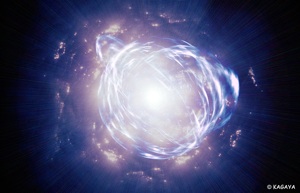nuclear astrophysics

understanding the origin of the elements, and the physics of exploding stars!
Burbidge, Burbidge, Fowler, Hoyle
Took the stars and made them toil:
Carbon, copper, gold, and lead
Formed in stars, is what they said
Ken Croswell
When we look at the world around us, we see that it is made of a variety of substances. Trying to understand what something really ‘is’, at a fundamental level, has been one of the main objectives of philosophers through the ages. I think it was Plato who first had the concept of an element; he had five elements, air, earth, fire, water and the ether, and somehow each of these was linked to the five regular sided solids (the ‘platonic solids’). Maybe the ancient Chinese had some earlier ideas of indivisible things? Skipping vast swathes of progress, it’s probably worth mentioning the work of Mendeleev who was the first to arrange the elements that we know of today into a periodic table, i.e. while others may have speculated on the patterns of the properties that the elements had, Mendeleev was the first to make a periodic table that had some deeper meaning behind it, giving some genuine understanding of what was going on, that is the role of atomic number and shells of electrons.
But where do these elements come from?
This insight was not really made until the middle of the twentieth century. The real breakthrough here came with the work of Geoffrey and Margaret Burbidge, William Fowler and Fred Hoyle (“BBFH”) in their 1957 paper Synthesis of the Elements in Stars. This explained how the abundances of essentially all but the lightest chemical elements could be explained by nucleosynthesis in stars. This work was paralleled by Al Cameron who also deserves great credit. It was then George Gamow who pioneered the theory of Big Bang Nucleosynthesis, which then explained the origin of the lightest elements.
Hence, a basic understanding of the fundamental origins of the elements has been achieved. But as scientists, we want to see this work in detail, that is, we want to quantitatively model it.
Experimental nuclear astrophysics concerns the measurement of the necessary nuclear information, and deducing the consequences for element formation and energy generation in astrophysical sites. This information may then be compared to observations or included in hydrodynamic simulations, testing and furthering our understanding of how and why the stars shine.
Present interests:
18F and gamma ray emission from novae
Novae provide an opportunity for direct observation of stellar nucleosynthesis through satellite-based measurement of gamma-ray emission from newly synthesised radioisotopes. The isotopic abundances inferred would provide significantly tighter constraints on models of novae than presently possible. Of particular importance is the abundance of 18F, as the annihilation radiation
from the b+ decay is thought to dominate the gamma-ray flux. It is produced via the 17O(p,a)18F reaction and by b+ decay of 18Ne, while it is destroyed by the 18F(p,g)19Ne and 18F(p,a)15O reactions. At the peak temperatures reached in novae, around 0.1–0.4 GK, the 18F(p,a)15O reaction dominates and its uncertainty is the greatest contribution to the variation of models.
44Ti and the mechanism of core collapse supernovae
Stars more massive than about 8-10 solar masses have only one fate: core collapse. Core collapse supernovae are remarkable astrophysical sites, representing one of the most extreme physics laboratories in Nature. They attract immense interest, both from the general public (e.g. cover story, Scientific American, October 2006), and from the scientists attempting to elucidate the physics that drives them. Perhaps the single most important diagnostic tool at our disposal is the isotope 44Ti. Unlike any other observable, it combines the specificity of isotopic (not elemental) abundance, can be observed promptly and directly by gamma-ray observing satellites or derived from examination of isotopic anomalies in meteorites, and its production can be associated with specific aspects of the core collapse mechanism. However, quantitative interpretation of such observations urgently requires that the key nuclear reaction rates involved in its synthesis be measured.

